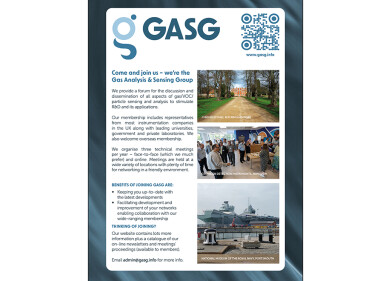Gas detection
CoGDEM Comment - Carbon Dioxide Detection
Jan 12 2016
CoGDEM is the Council of Gas Detection and Environmental Monitoring, a trade association with a membership of around sixty companies involved in the gas detection industry. We are pleased to have ILM/ETP (the publishers of this IET magazine) as an Associate Member, so we now place a regular column of news from the gas detection industry in IET magazine.
Carbon dioxide (CO2) is very topical within the gas detection industry at present, and the detection, sensing, monitoring and alarming of CO2 are at the forefront of development within many CoGDEM companies, often using innovative low-power infrared absorption techniques.
In recent years, the true toxicity of CO2 in the workplace has been identified and publicised, including articles in IET by HSE and others. For example, it was common practice in the alcohol brewing and distilling process industry just twenty years ago to monitor oxygen deficiency as the only means of protecting workers from exposure to excessive CO2. However, it had to be pointed out that oxygen levels may only be very slightly depressed by the time a CO2 concentration exceeded Workplace Exposure Limits. In the UK the HSE’s EH40 document shows the WELs for CO2 to be 0.5% (8-hour LTEL) and 1.5% (15-minute STEL). These levels indicate that CO2 is a toxic gas in its own right, not just an asphyxiant when it displaces enough oxygen. Carbon dioxide detection instruments using these alarm thresholds have become commonplace in relevant industries.
A recent announcement from the UK Government has brought CO2 back into the headlines. ‘Carbon capture and storage’ (CCS) is a technique to reduce carbon dioxide emissions to atmosphere by trapping the CO2 from large scale industrial processes such as fossil-fuelled power stations and refineries, ‘storing’ it permanently in huge underground voids, both natural and man-made. CCS is recognised globally as a useful technique to help deal with climate change, but the process itself involves obvious difficulties when transporting and storing large volumes of pressurised toxic gas. CO2 producing companies are being encouraged to come up with innovative schemes and a £1billion competition had been launched by the UK Government, but it was announced in November 2015 that the ring-fenced money will no longer be available. As a direct result of this decision, some major projects have already been cancelled.
In smaller scale combustion appliances, CO2 production represents a real hazard if the fumes are not dealt with properly. A soon to be released report is likely to show that modern domestic housing with extremely low air-change rates can see CO2 levels exceed workplace exposure limits. This can also be the case in schools and colleges, and CO2 monitoring is now a technique recognised within guidance documents for checking the efficacy of ventilation arrangements. Hand-held inspection instruments compliant with EN 50543 are used for surveying work, and some of the new generation of Flue Gas Analysers have direct reading CO2 sensors fitted. Fixed detection equipment can be linked to air intake controllers to keep the ambient environment within agreed limits.
Commercial catering establishments, whether restaurant kitchens or food processing factories also can see enhanced CO2 concentrations in the ambient air within the breathing zone of workers, and it is a legal requirement that gas burners and cookers can only be used if the ventilation fans are switched on and actively extracting the unwanted products of combustion. In many cases it is now acceptable to use permanently installed CO2 monitors as part of the ‘interlocking’ equipment, so that energy-intensive fans can be on ‘tick-over’ unless the concentration exceeds set limits. Similar detection equipment is also used to warn of the leakage of CO2 from tanks and storage cylinders in pub cellars and fast-food outlets where it used in the carbonation of fizzy drinks. Bulk CO2 delivery drivers are now commonly equipped with personal monitors, as there have been exposure incidents when pipe connections are faulty.
Digital Edition
AET 28.4 Oct/Nov 2024
November 2024
Gas Detection - Go from lagging to leading: why investment in gas detection makes sense Air Monitoring - Swirl and vortex meters will aid green hydrogen production - Beyond the Stack: Emi...
View all digital editions
Events
Jan 12 2025 Abu Dhabi, UAE
Jan 14 2025 Abu Dhabi, UAE
Jan 20 2025 San Diego, CA, USA
Carrefour des Gestions Locales de L'eau
Jan 22 2025 Rennes, France
Safety, Health & Wellbeing LIVE
Jan 22 2025 Manchester, UK



















